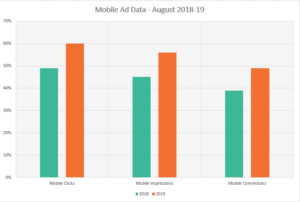With Mobile Traffic Rapidly Rising, Why Are Desktop Conversions 93% More Valuable?
A recent study done by AccuraCast has shown that mobile traffic is rising rapidly, however desktops are still preferred for transactions. The study discovered that while 60% of ad clicks in the last 12 months have come from mobile devices, desktops convert 60% more. Consumers use their smartphones for everything, yet they’re still not comfortable converting from them. This phenomenon is starting to raise many questions for marketers and advertisers. Are mobile ads driving the right traffic? Does mobile ad spend even have real value?
Results
For this study, AccuraCast analyzed 10 million clicks across 100 ad accounts over a 12-month period, comparing click and conversion trends between mobile and desktop. It was discovered that mobile ad clicks have increased by 11% from last year (49% to 60%), and mobile ad impressions rose by 6% (45% to 56%). Mobile conversions also rose 10% this year (39% to 49%).

Source: AccuraCast
While mobile traffic increased significantly and conversions rose slightly, it was discovered that the overwhelming majority of conversions still come from desktops. Desktops convert 60% more than mobile users, and desktop conversions are worth 93% more than mobile.
Historically AOV for desktop transactions has been higher than mobile devices. This has been found by multiple other studies and reports. As a generalization, consumers browse on mobile devices, but tend to go back to desktops to make final purchases.
Issues with Mobile Conversions
AccuraCast believes the reason for higher mobile impressions but lower conversions lies deeper in problems with the mobile user experience. These include issues such as:
- Low quality apps and/or sites driving traffic but not conversions.
- Low performing landing pages that make transactions difficult.
- Ineffective ad placements that lead to worthless clicks.
Takeaway Recommendations
1. As mobile visitors continue to rise, so should the quality of your mobile site and/or app.
Mobile interfaces continue to improve, and users are expecting them to. Being mobile friendly is important across all industries. This means some companies should consider designing for mobile first, instead of desktop site. If you design mobile first you can leverage the larger screen real estate available on a desktop platform as a second step. It’s important to understand we are not suggesting this because desktop is dead. As the study has shown, it’s not at all, it’s still very important. But it’s far easier to take a mobile UI to the desktop than to take a desktop one to a smartphone.
2. Desktop still remains at utmost importance.
To reiterate, data continues to prove conversions happen on desktops majority of the time, so you must continue to pay attention to your desktop site. Most consumers use more than one device when making a purchase. For example, someone may browse a store on their mobile phone, then go to their desktop to actually make a purchase. Because of this it’s smart to offer users on mobile devices the option to provide contact information, save shopping carts, or implement other functionality that allows them to defer the actual completion of a conversion to a later time.
The rationale is that users may not want to deal with complicated forms or enter their credit card information on mobile devices. Following up with them later lets them come back on a desktop and convert at a more convenient time for them. If you adopt this strategy, it’s recommended to test it thoroughly to see which system gets the best results.
3. Compare your site’s behavior to industry norms.
If the average percentage of mobile visitors is 60% and your site is only at 35%, that may indicate an internal issue, such as a slow mobile site. Check how you compare to industry norms. If there’s a large delta, take the time to perform an audit to understand why.
Final Thoughts
For years now, industry experts have advised businesses to speed up and simplify the mobile user experience. As it’s been heavily forecasted that conversions and revenue from mobile devices will be growing rapidly. The results of this study show there’s still some distance to go. However, the desktop and mobile devices should not be seen as mutually exclusive channels. Most shoppers use multiple devices to make purchasing decisions.
More from Onimod Global
To catch up on the latest digital marketing news and trends, click here. To find out more about who we are and what we do, click here!

